Technology
Services
Resources
There’s a lot of noise out there, and as more marketers continue to adopt programmatic advertising, we will try to clear the air. Which brings us here—about to shed light on a few of the grey areas within the complex digital ad world we all know and love. Let’s bust some myths!
A common point of confusion in the world of digital media buying, this is one of those “same, same—but different” situations. Technically, programmatic is the automated format of ad buying – one computer talking to another computer to execute campaign operations, while real-time bidding is just one type of programmatic buying. Programmatic ad buying alone automates certain tasks (insertion orders or ad tagging, for example), which ultimately empowers ad buyers to build more sophisticated strategies, pull better analyses, and pivot more effectively amid industry shifts.
Real-time bidding, or RTB, is a technology protocol or mechanism for automatically bidding, buying, and selling display impressions via an auction format. It’s the lightning-quick auction that takes audience data into account, to assess the value of an impression to a certain advertiser (BannerConnect, 2017). In short, advertisers compete for an impression, or ad space, on a web page with automated bids. The highest paying bidder wins the auction and placement on that particular web page (which is then loaded immediately). Therefore, while RTB absolutely equals programmatic, programmatic does not exclusively equal RTB; RTB is but one piece of programmatic.
Read more about other differentiators here.
Let’s be honest. Between click farms, bots, and human traffic (yes, the end users are real), fraud is prevalent in today’s world. According to Juniper Research, advertisers lose $51 million per day on ad fraud, which may add up to well over $19 billion in wasted ad spend by the end of 2018 (SearchEngine Journal, 2018). Those numbers aren’t small. However, according to the Association of National Advertisers (ANA), as media agencies have improved controls and filtration processes, fraud experienced in programmatic buys, is no longer riskier than general market buys.
The Integral Ad Science (IAS) 2017 Media Report data states that when appropriate precautions are taken (automatic pre-bid filtering, for example) the fraud rate isn’t that different at all—in fact, they saw slightly lower fraud rates on programmatic buys for desktop displays in the US (Integral Ad Science, 2017). The video numbers (in the US) are barely higher for programmatic, and it plays out the same globally. Overall, programmatic has either lower rates of fraud or a very small difference, as long as the proper precautions are being taken.
Have there been cases where suspect publishers supplied the RTB ecosystem with questionable inventory? Yes. However, most of the quality players (SSPs and DSPs alike) actively work to remove such inventory from the marketplace, as low-quality inventory benefits nobody in the long run.
In today’s landscape, we can potentially purchase the very same impression that would otherwise have been available to a Direct Buy campaign. In the beginning, RTB was viewed as a means of monetizing inventory that was not directly sold—this is far from the truth today. Advances such as header bidding, means that for many publishers, every impression is potentially available through RTB. Header bidding is a new, unified auction conducted by publishers outside of their primary ad server, which allows advertisers to cherry-pick impressions at the highest priority; it is also known as “first look” (AdProfs, 2018). Header bidding has enabled publishers to maximize their revenue by taking the best price available for any given impression—in many cases, that may be a directly sold campaign, but if a programmatic source offers a higher CPM, the publisher’s ad server can choose that source instead.
Attitudes have also significantly shifted amongst publishers. Previously, publishers may have viewed RTB with suspicion and intentionally withheld valuable inventory. Today, however, most publishers recognize that making every impression available for purchase by the highest bidder is truly in their best interests.
The “black box” terminology doesn’t come from programmatic buying, but rather, the business models companies offering programmatic buying services choose to offer. An advertiser can engage in real-time bidding by sending an insertion order to the company that runs their campaigns and send back only basic stats. In that regard, it’s not that different than buying directly from an ad network. However, advertisers also have the option of working with partners who promote transparency and show them everything—or even take the reins themselves and decide how every aspect of the campaign should run (outsourced managed services). For most major DSPs, what a self-service customer sees, is exactly the same as what a buyer who works at that DSP can see.
At its core, programmatic buying promotes transparency and increases the amount of control buyers have when it comes to when and where their ads are displayed. Reporting will vary by vendor, and platforms that pride themselves on providing maximum transparency will report on multiple levels of granularity, including but not limited to: campaign, domain, placement, creative, and more (MarketingLand.com). The programmatic advertising industry as a whole is continuously searching for more transparent methods, including better tools for reporting and tracking.
Programmatic buying is both an art and a science. Sure, the algorithm (scientific component) gets most of the glory, but people are still needed to pull the levers. Basically, the human element is crucial to thoughtful execution. Algorithms are only as good as the data that feed them, and data is only as good as the strategies it informs. There is also something to be said about thinking long-term versus short-term. Algorithms generally address the details of any campaign in any given moment, but (human) experts have years of experience and accumulated knowledge about what works for the brands they buy for. Most algorithms will have to learn this over and over again and don’t have the benefit of long-term insights.
In addition, there is a strategy behind the optimization of the ad campaigns and media buying implementation (yes, humans, this is where you come in), as well as the personal relationships that come into play between the programmatic firms and agencies. The internal culture of a programmatic firm can also dictate success. Chances are, if employees feel engaged and trusted, they will perform to the best of their ability. People are the innovators, groundbreakers, and builders that optimize campaigns to yield the highest results, develop brilliant creative, and work together to decide what the future holds. Automated platforms help bring data to life, but the whole picture wouldn’t be complete without human intuition.
As noted by IAS, political, economic, cultural, and media trends can all impact media quality metrics and also be reflected by them. As the ad tech industry continues to ebb, flow, and grow, it’s important to stay abreast of the major shifts and intricate changes that make this digital world so exciting. On that note, consider these myths—busted!
Learn more about Programmatic Advertising with Basis.
Humans are a social species: We all want to belong. Being part of a community allows us to feel safe, support each another, and discover shared experiences. Most importantly, it builds valuable relationships and gives us a sense of belonging.
At Centro, our goal is to create that sense of belonging by fostering community in our workplaces. Our programs and initiatives are geared towards working to ensure that people of all identities can join us, create valuable relationships, and bring their whole selves to work.
Centro Community Groups (CCGs) are one initiative we’ve kicked off to better cultivate a culture where everyone recognizes the power of their uniqueness. These employee-led, employee-organized groups are centered around common identities, interests, life experiences, and backgrounds.

Our list of CCGs is growing quickly! Here’s what’s Centrons have organized so far:
As a company, we are committed to supporting these groups both financially and via professional development. Every month, members of Centro’s leadership team will meet with Community Group leadership to ensure that we’re cross-collaborating and providing mutual support. We also provide an external Diversity, Equity, and Inclusion consultant to train Community Group leaders so that they're well equipped for facilitation.
We realize that there’s no end to the work of building an environment where everyone feels that they belong. We realize that we will fail and make mistakes along the way. And, we are committed to transparency, persistence, and humility as we continue our journey to a more diverse, equitable, and inclusive workplace.
Curious about what it’s like to work at Centro? Learn more here.
Being at the right place at the right time can make all the difference in digital. It's especially important when you're running programmatic ad campaigns, because finding the exact audience you're looking for and meeting them where they're most likely to see and act on your ad means you won't waste impressions or ad dollars.
Let's use an example: If you were to launch a campaign promoting lunch specials, and you ran it on desktops only, then you'd be targeting the right audience, because you're reaching the hungry masses at their desks. So, great, you've got your audience, and you're fishing in the right pond.
But have you caught them at the right time? Maybe your lunch special ad isn't as effective on desktops because people ate an early lunch, or they're sitting in a three-hour meeting and aren't able to leave the office.
What if you could show them the lunch special ad while they're walking through the food court – which is, of course, conveniently located right next to your business. You'd achieve the most important recipe to programmatic success: right place, right time, and no wasted impressions.
Mobile and smartphone ownership and usage is extremely prevalent in our technologically driven world. According to eMarketer, mobile users spend over four hours on their smartphones each day, and most of that time is spent on mobile apps. In addition, comScore reports that "mobile apps account for 57% of all digital media usage, and smartphone apps alone capture more than half of digital media time spent."
Those are valuable views your ads could be getting, and taking advantage of the mobile space in programmatic advertising is critical. Luckily, programmatic opens up the option of precise location targeting or a mobile app campaign. When running a mobile app campaign, geotargeting – also known as hyperlocal targeting or mobile geo targeting – is a very commonly used campaign targeting tactic.
When an app is downloaded, it will ask permission to collect a user's location data. In many cases, the app provides filters or geospatial features that require location tracking to be on. Once enabled, the app knows the user's GPS coordinates at all times.
These coordinates are extremely useful to an advertiser buying in-app impressions. By utilizing mobile geotargeting and tapping into the GPS information on a user's mobile device, you can capture their exact location and target based on coordinates and radius.
And by pinpointing the exact consumer for your campaign needs, you can use real-time location information to target users in the exact moment where they are where you want them to be. You're no longer wasting lunch ads on the hungry woman at her desk. You're showing lunch ads to the hungry woman in the food court who's busy deciding what kind of food she's in the mood for.
Using coordinates and a surrounding radius, you can create a geo-fence, allowing you to leverage location to target unique audiences for different digital strategies:
One other success tip: Use dynamic mobile creative that delivers a localized message to potential customers. This helps to deliver highly relevant ads to users in the right location.
Learn more about Programmatic Advertising with Basis.
Every year there are new marketing strategies and approaches to start investing in. It’s challenging to keep up with what they all are, why they’re effective, and how to adopt them. An omnichannel marketing strategy is one of the latest on a long list of options for marketers to consider. Those who understand what omnichannel marketing is all about know just how it drives key business goals. Once you understand what the strategy is and how it works, it’s easy to see why it represents the future.
Before laying out the benefits of developing an omnichannel marketing strategy, it’s important to define what it really is. Marketers today often confuse omnichannel marketing with multichannel marketing. They’re actually quite different.
Multichannel marketing involves reaching out to audiences on a number of different channels with the same marketing message. The goal is to reach as many potential customers as possible by targeting a wide range of channels. Say, for example, a business is promoting a summer sale. With a multichannel marketing strategy, they would send out the same sale announcement through email, social media, and on their website.
Omnichannel marketing likewise involves reaching out to audiences on different channels, however, the goal with this approach is to engage and interact with the same audience members in various places around the web. Rather than delivering an identical message to everyone, an omnichannel strategy adapts to insights about audience needs and their point in the customer journey. Let’s pretend that a business promotes a summer sale to their audience through email. With an omnichannel marketing strategy, they wouldn’t deliver the same marketing message on social to audiences who already saw the email promotion. Instead, they would adapt their message to upsell or encourage other behaviors related to the campaign goal.
With omnichannel marketing, you need extra tools, tracking technology, and an advanced strategy to succeed. It takes more time, money, and resources than simpler marketing strategies. That said, the benefits greatly outweigh the costs when used the right way. Here are a few:
1. Better data analysis
In order to effectively execute an omnichannel marketing strategy, you need to be able to track the behavior of individual audience members across disparate platforms on the web and offline. Such platforms include:
Doing this effectively will allow you to build a complete view of the customer journey. By tracking and then collecting both online and offline behavioral data, marketers are empowered to pinpoint customer behaviors and better understand their interests and intent.
2. Nuanced segmentation and targeting
A great many marketers don’t realize they need a better picture of their customer journey until they start investing in omnichannel data collection. Once they do, it’s possible to gain more accurate and nuanced insights than originally thought possible. Segmenting your audience based on deep funnel intent data opens up many new targeting possibilities. Businesses can design more effective marketing campaigns that truly speak to the demographics, interests, and needs of audience segments.
Say, for example, a furniture store is delivering remarketing ads to someone who previously browsed baby cribs on their eCommerce site. The customer then goes into their physical store and purchases a crib. Without online/offline data integration, the company would continue showing ads for cribs, which isn’t relevant to the customer anymore. With an omnichannel marketing strategy, the business could switch to marketing other baby-related products to upsell and increase customer lifetime value.
3. Improve brand visibility
The online shopping experience has changed considerably in recent years. Twenty years ago consumers used one or two touch-points to make purchase decisions. Now, it’s common to have four or more:
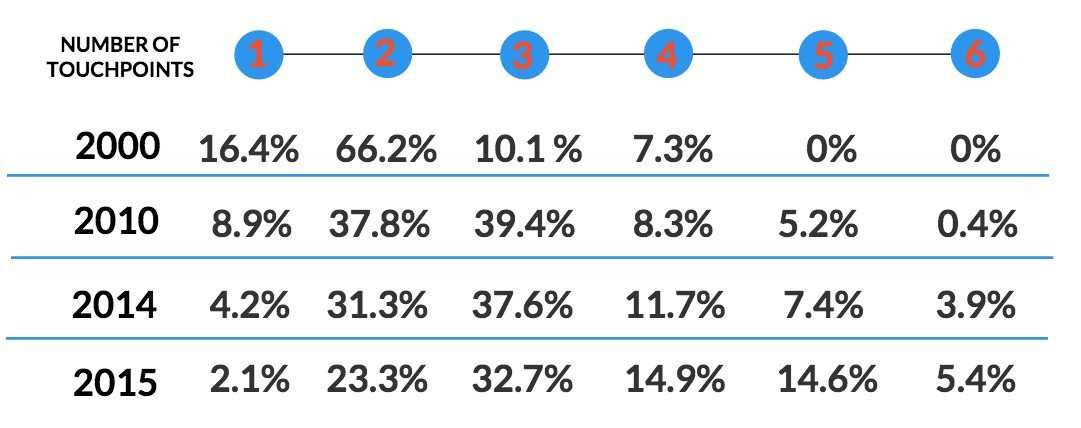
Investing in omnichannel marketing makes it possible to share your brand message consistently online, offline, in-store, and on mobile. Creating a seamless experience across all of these relevant channels gives your brand more visibility and offers the opportunity for audiences to interact with your business wherever they prefer. This can help drive other important goals like engagement and sales.
4. Create better engagement with your audience
Improving customer engagement has a plethora of benefits for businesses, such as moving leads down the funnel, driving sales, and increasing customer loyalty.
It goes without saying that reaching your audience on more channels provides more opportunities for engagement. Omnichannel marketing does more than that, though. Providing a consistent and relevant marketing message that traverses multiple platforms encourages audience members to engage more than traditional multichannel marketing. Since the message is fluid and changes based on interactions on other platforms, it becomes more relevant. This increases clicks, shares, form fills, and other important engagement metrics.
5. Improve collaboration across teams
Sharing data insights from cross-channel marketing can help businesses improve cross-team collaboration in a lot of ways. Look at sales and marketing alignment, for example. Understanding how individual consumers interact with your brand across touchpoints can help sales teams improve the in-store shopping experience. Tracking a customer’s previous interactions online and offline can also help customer service representatives solve problems and complaints more quickly.
6. Increase sales
All the benefits of an omnichannel marketing strategy can work together to drive one key goal: sales. Plenty of research has shown that adopting an omnichannel strategy encourages people to make purchases and then repeat purchases. According to Omnisend’s 2020 Marketing Automation Statistics Report, the purchase rate of campaigns using three or more channels is 287% higher than single-channel campaigns:

Increasing brand awareness, engaging your audience with a targeted message, and providing better customer service all work together to help a business drive more sales. Offering a seamless experience also makes it easier for customers to find the products they need and buy them, regardless of the platform.
7. Improve customer retention
A recent Aspect survey found that businesses adopting omnichannel strategies achieve 91% greater year-over-year customer retention rates compared to businesses that don’t. There are many ways businesses can improve customer retention through an omnichannel approach to marketing, sales, and customer service. A great example of this in action is the Starbucks Reward Program.
People have masses of choices when it comes to places to buy a cup of coffee, but Starbucks has a great omnichannel marketing strategy that keeps people coming back to their locations. They offer a free rewards card to use when you pay, but you can also refill it via phone, website, in-store, or on the app.

Whichever platform you prefer to use, your card balance updates in real-time. You can also order your custom drink from the app, order and pay ahead, and collect points for special rewards every time you use it. Comparing that to a traditional reward punch card shows what a real omnichannel customer retention strategy is all about.
8. It’s cost-effective
On the surface, it might seem like developing an omnichannel marketing strategy is expensive. You have to invest in the right tools and approach to collect your audience data, analyze it, and then surface insights to deliver a consistent marketing message across channels. However, when you do it the right way, all the investment more than pays for itself.
Developing more accurate performance insights helps businesses allocate their marketing budget more effectively. Having a full picture of the customer journey can empower you to understand which channels are most valuable in driving sales and improving customer retention. This way you can make informed decisions to invest more or less in certain channels, targeting strategies and marketing campaigns. Improving marketing spend efficiency and effectiveness makes omnichannel marketing a very cost-effective business strategy.
While most brands will undoubtedly invest in multichannel marketing in 2020, few will prioritize building a seamless, relevant experience for all audience members across different platforms. That said, adopting marketing intelligence technologies and strategies that allow for true omnichannel operations is on the rise and the approach is well on its way to becoming the standard for businesses both large and small.
Early adopters of an omnichannel strategy are set up to outperform their competitors in a lot of ways over the next few years. Soon it will become mandatory for businesses to update to a modern strategy if they want to stay in the market. Beyond that, there will be a few key strategic factors that allow businesses to keep up with audience expectations and outperform their competitors with omnichannel:
Data Quantity and Quality Management
As online marketing channels continue to grow, so does the digital foot of consumers. The more relevant data you can incorporate into your performance analyses, the better insights you can garner, and the better optimizations you can make. Competitive omnichannel marketers should invest in technologies with the capacity to analyze first party, second party, and third party data to help paint a clear picture of the marketing landscape.
Managing data quality is another important success factor. Data checking and validation can help reduce noise in performance analytics, making insights more accurate and valuable for businesses.
Nuanced Modeling and Attribution
While data quality is important, it doesn’t matter unless you’re prepared to analyze it properly. Once you have a full picture of the customer journey, you need to be able to decide which touchpoints are most valuable for driving key business goals.
Simple models like first and last-click attribution aren’t detailed enough for an omnichannel marketing strategy. Businesses need to invest in tools that can effectively attribute value to all relevant touchpoints. Thanks to artificial intelligence and machine learning technology, it’s also possible to project future performance based on past data insights. Businesses that make full use of their audience data can make informed decisions based on historical performance as well as the current marketing landscape.
Operationalizing Insights at Scale
Lastly, creating accurate performance models is only valuable if you can make quick optimizations based on insights. Lots of businesses today have a wealth of performance insights to inform their marketing decisions, yet few have the capacity to act on these insights at scale.
For example, day-to-day changes in the PPC landscape offer opportunities for advertisers to change bids and outrank their competitors in search results. However, it's just not possible for marketing managers to make hundreds or even thousands of micro-optimizations per day. The solution is to invest in paid search management software that can make bid optimizations for you in real-time.
An omnichannel strategy isn’t a radical new way of marketing. It’s just an attempt to consolidate your approach in an increasingly complex marketing landscape (online and off). Consumers are beginning to demand an omnichannel customer experience because they know it’s possible. Businesses that want to please their audiences and keep up with the competition need to start developing a more integrated approach to marketing. Once you accept an omnichannel marketing strategy as the standard, then you can focus on optimization tactics like improving data quality, predicting performance, and operationalizing insights.
Today, PPC advertising is the best way for travel marketers to reach and convert new target audiences. With revenue opportunities only continuing to grow, digital travel sales are expected to exceed 800 billion dollars in 2020, according to Statista data. Investing smartly in effective travel and tourism PPC tactics can help an array of businesses earn their share of digital travel revenue this year and beyond. This ultimate guide explores the strategies with the most opportunity for growth.
Most travel and tourism PPC tactics revolve around promoting hotel rooms and travel bookings. However, there are lots of other opportunities to earn revenue from PPC in the travel niche. Tourists today spend $129 billion on travel-related activities. That’s a huge share for travel companies to tap into.
Expectations and preferences surrounding travel have changed a lot in recent decades. 67% of high-income travelers would rather spend money on activities and experiences than an expensive hotel room. Travel marketers can take advantage of this trend by promoting tours and activities with their PPC ads:
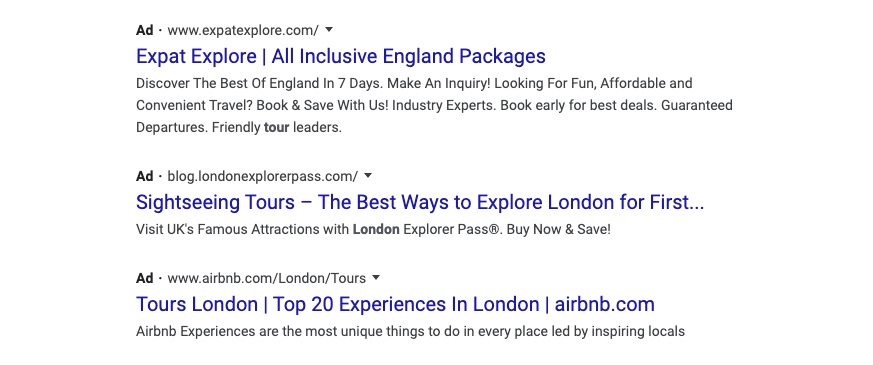
Travel companies that don’t traditionally focus on offering experiences can also adapt to this new trend by creating new services. That’s exactly what Airbnb did by launching AirBnB Experiences last year (which they now promote heavily through PPC ads).
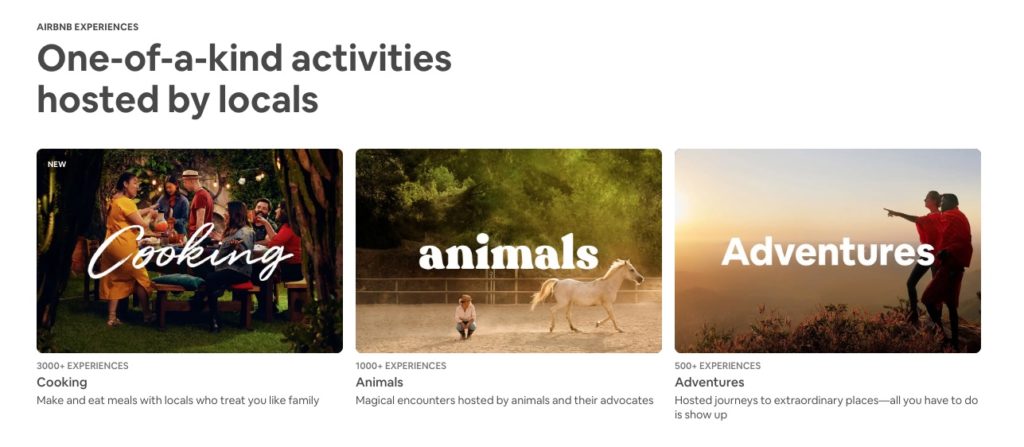
The travel space has become massively competitive over the past decade. When budgets are limited, it’s a challenge to outpace PPC competition and reach audiences at critical points. In order to stay competitive, travel and tourism companies need to focus their spending on keywords that drive more conversions.
All sorts of relevant keyword phrases can be targeted to engage audiences at different points across the customer journey. Some have higher conversion value than others. For example, a travel company with destinations in Spain could target long-tail keywords like “best time to visit madrid” or “things to do in barcelona.” These are informational queries that show users are just researching. They’re not necessarily ready to purchase a ticket, tour, or hotel room.
Instead, it’s better to allocate more budget to target keywords that show users have high purchase intent, such as “buy tickets to barcelona” or “book costa del sol tour.” These queries suggest that users have done their research and are ready to buy.
There are also lots of opportunities to reach people as they’re about to convert by targeting location-based queries. According to Google, nearly half of experience bookings happen after travelers arrive at their destination:

Your previous campaign performance can tell you a lot about what demographics are likely to convert on your ads, as well as when, and where. Use this information to create new targeted ads and landing pages to improve campaign performance.
There are numerous pre-defined reports in Google Ads that can give you insights into the performance of different dimensions. For example, you can look at impressions and clicks by geographic location:

You may discover the people searching from a specific geographic region are more likely to click and convert on ads promoting a local tour. You can take advantage of this by increasing bids for audiences in that location. If there’s a major performance opportunity in a dedicated place, you could also create unique ads and landing pages tailored specifically to them. Creating more relevant content for your ads and keywords can also improve your Quality Score and Ad Rank.
Geo-targeting isn’t the only option to optimize your bids and targeting. You can adjust bids for different times of day or days of the week that tend to perform better as well.
Mobile optimization is important for any PPC campaign. However, it’s a particularly important travel and tourism PPC tactic. Consider these statistics:
As mentioned above, people also use their mobile devices to book experiences while traveling. Simply put, people use mobile devices when conducting searches related to travel more so than in other industries.
To invest more in mobile, marketers need to prioritize optimizing their pages for mobile and then consider bidding more on mobile to get visibility. Search results have less real estate on mobile devices. In order to ensure people see your mobile ads on tiny screens and click on them, you need to target positions 1 and 2 in search results.
To monitor your ad rank performance on mobile versus desktop, go to the Devices page, click Columns>Modify Columns. Then add Impr. (Top)% and Impr. (Abs. Top)% to your reports:
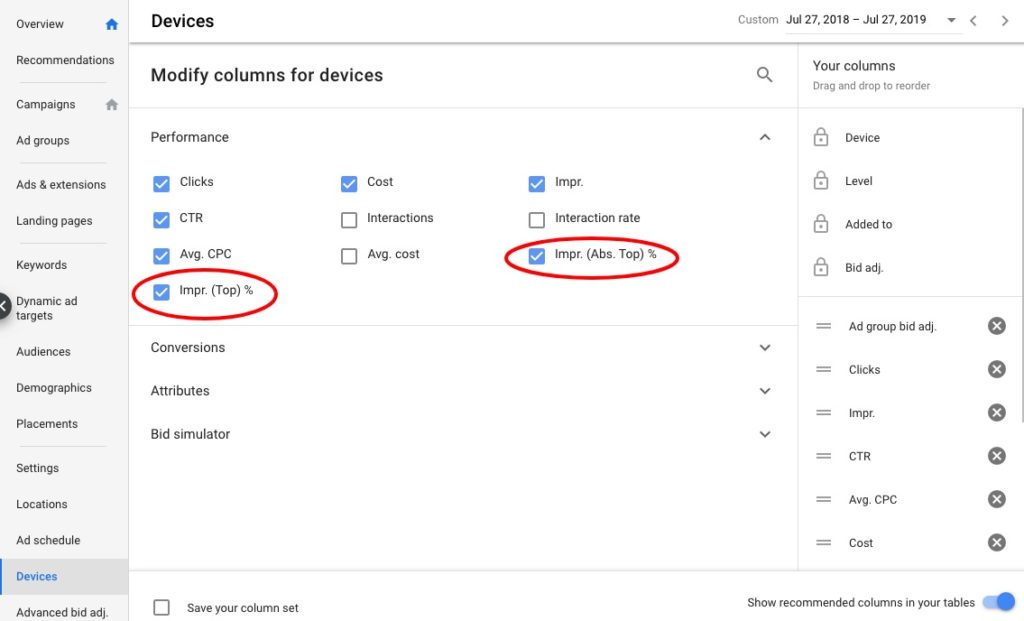
This will show you if you’re bidding enough on mobile devices to achieve an ad position that will get you visibility.
Travel and tourism PPC tactics should include personalization as much as possible. Personalizing your content can increase clicks and conversions considerably. People have also begun to expect it as part of a good user experience. According to a Travolution survey, 81% of respondents say delivering personalized experiences is very important to them. Best-in-class travel companies deliver this throughout the customer journey using accurate ad targeting and dynamic web content.
As an example, if you search “cheap london hotels” on Google, the headline of every ad listed speaks to that specific pain point (affordability).

And, when you click on one of these ads, the resulting landing page is also personalized to this need. Hotels.com, for instance, shows offers for discounted hotels and special pricing options. They also adapt their landing page copy based on the location of the searcher:
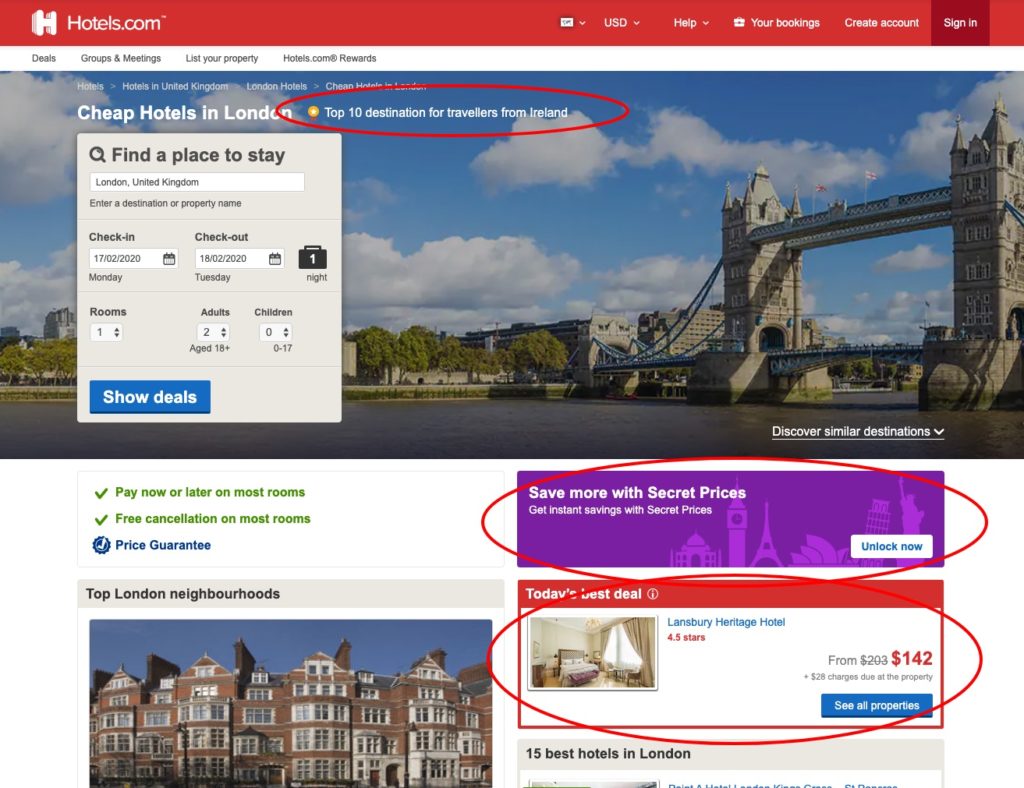
Inherently, travel is about having new experiences in unique places. Few people are interested in trying new things without strong recommendations from others. When people look for travel information online, they rely on reviews and ratings from others to make decisions. According to Tourism Research Australia, people say review websites are the number one source that influences global travel decisions, ahead of travel agencies and tour operator sites.
Google has made a lot of effort to include reviews right in search results. If someone searches for your brand by name, they’ll see reviews along with your information from Google My Business:
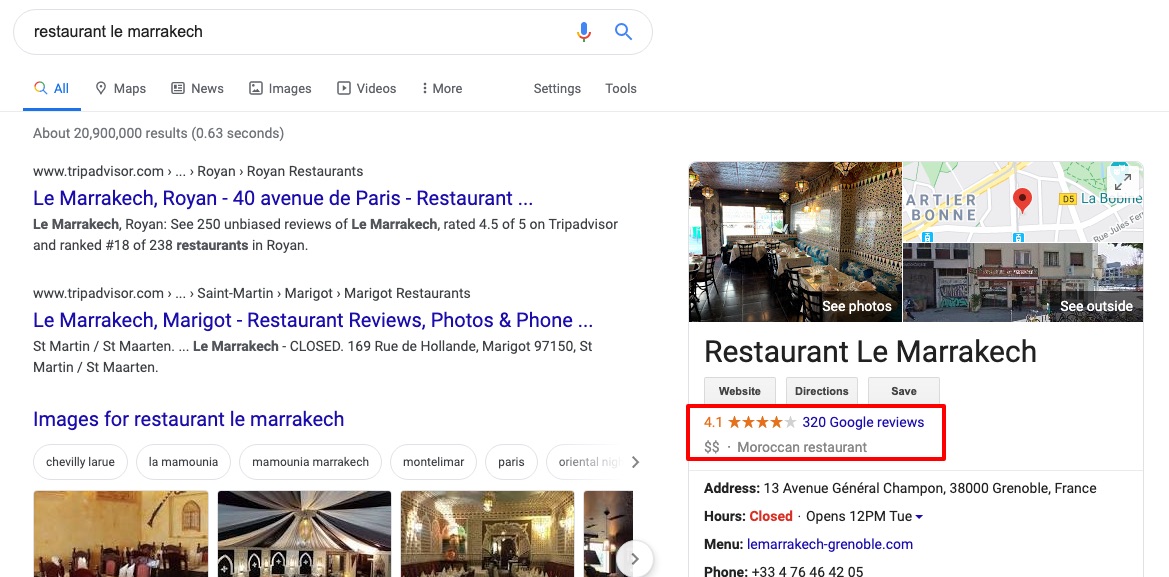
Reviews also show when your business appears along with other listings in local pack search results:
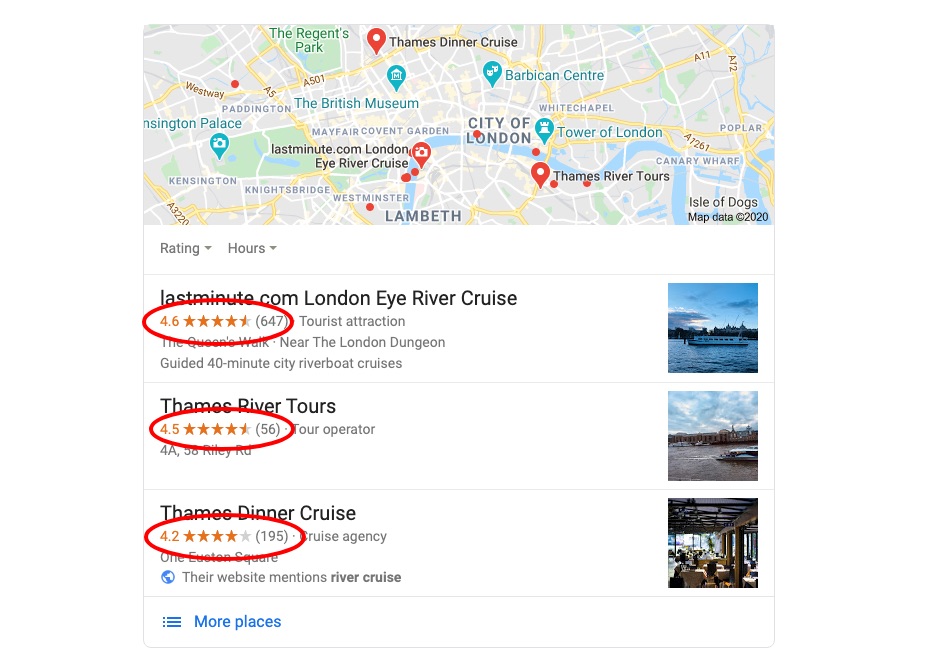
And even if people find your business through search results, they’re likely to turn to other review platforms (like TripAdvisor) to learn more before making a purchase decision. Reputation management, then, must be a priority across relevant platforms.
User experience optimization is one of the most important travel and tourism PPC tactics. You can invest a lot in creating your ads and optimizing ad targeting, but if your booking experience is difficult, you’ll get few conversions. People have many options for booking travel online. If your booking experience is confusing, they’ll simply go back and find an alternative option.
The first aspects to consider when looking to enhance user experiences are mobile-friendliness and site speed. Both of these are important Ad Rank factors for Google PPC. The next thing you need to consider is site navigation. Is it easy for visitors to find the content they’re looking for on your site, regardless of what page they landed on?
Lastly, you need to optimize the booking process itself:
Even small changes such as consolidating your booking fields or reorganizing a page can improve conversion rates. Whenever you make changes, flag the days in Google Analytics so you can understand their impact on performance.
Your PPC ads should largely be focused on driving conversions. Your advertising strategy as a whole, though, should also include techniques to build brand awareness. Keeping your brand name at the top of people’s minds is more important in the travel industry than in others. In a survey conducted by SEMRush, it was found that 52% of travel site traffic is direct, followed by search at 32.2%.

So, even if your ads don’t drive conversions directly, they can build brand awareness, encouraging your audience to revisit your site when they’re ready to convert.
One way to prioritize building brand awareness is by supplementing your search ads with Google display or Facebook Ads. You can use them to remarket to audiences that clicked on your PPC ads but didn’t convert, or target similar audiences to broaden your reach across platforms.
An impressive 79% of travel marketers already use Facebook Ads. The platform has an ad type specifically designed for the travel business, so you can get more bookings, show complimentary offers, and build your brand image on the web.

Once you start building a strong image for your travel brand online, it makes sense to start bidding on branded keywords. Users who are familiar with your business are much more likely to search for it directly. Even if your pages are ranking well in organic search results for branded terms, it’s worthwhile to double down with PPC ads. Research has shown that clickthrough rates are higher when a brand appears in both organic and paid search results.
As your online authority grows, competitors are also likely to bid on your branded keywords to get more visibility. As a result, bidding on branded terms is also necessary to beat out the competition, getting the clicks and traffic you deserve.
Seasonality data should inform how you set up your campaigns and optimize them to maximize the value of the travel season. Your previous Adwords performance data can show you which times of the year bring a higher search volume for different locations and experiences you promote. Create separate campaigns for the different destinations you’re targeting so you can easily start and pause campaigns throughout the year. This makes it easier to distribute your advertising budget to the locations that matter most.
You can also rely on seasonality trends to inform what kind of bid adjustments you should make. Even if you create separate campaigns for different destinations, there will still be micro-fluctuations within the busy season that you can take advantage of. The best way to do this accurately is with automated bidding strategies. For example, Google’s Smart Campaigns consider seasonality factors when automating bidding decisions.
Investing in targeted travel and tourism PPC tactics is essential to stay ahead of the competition today. The industry continues to grow year after year, as do the opportunities to target and reach travel audiences through PPC.
Start by systematically investing in each of the strategies in this ultimate guide. Monitor performance to see which are the most valuable at helping you reach your revenue goals.
Once considered a soft option for PPC advertising, Bing Ads now offers a wide array of opportunities for advertisers to reach their desired audiences and drive meaningful revenue. Last year we published some tips and secrets on how to expand your SEM strategy using Bing Ads. Since then, the platform has undergone a lot of changes. For one, Bing Ads rebranded as Microsoft Advertising, and that’s just the tip of the iceberg. They also launched a plethora of new features to help advertisers improve campaign performance and grow ROI. If you want to maximize the value of Bing Ads for SEM in 2020, here are 13 new tips and strategies to consider.
Bing allows you to import your Google Ads account and campaigns over to its platform. While this makes it incredibly easy to get started with Bing SEM, it does, however, mean that few marketers actually set about the task of optimizing their campaigns for Bing Search. That’s why it’s important to take advantage of Bing’s own research functionalities to generate targeted changes and get a head start over your competition.
For example, Bing Ads has its own Keyword Planner tool that marketers can use to build unique keyword lists. Bing’s audience is very different from Google’s, and so select search queries will be more or less relevant and elicit a different search volume on Bing versus Google. Bing’s Keyword Planner comes with some unique features, such as allowing you to build negative keyword lists. It also shows statistics and suggestions with up to six months worth of historical data.
Microsoft Ads just launched a series of new features that make it easier to manage shopping campaigns using Microsoft Advertising Scripts. Smart advertisers can utilize these functionalities to save time and optimize campaigns more effectively. The new “list view”, for instance, makes it possible to filter, sort, and pivot Product Groups to make bulk changes.

You can also easily view performance data side-by-side and enable percentage-based bid changes.
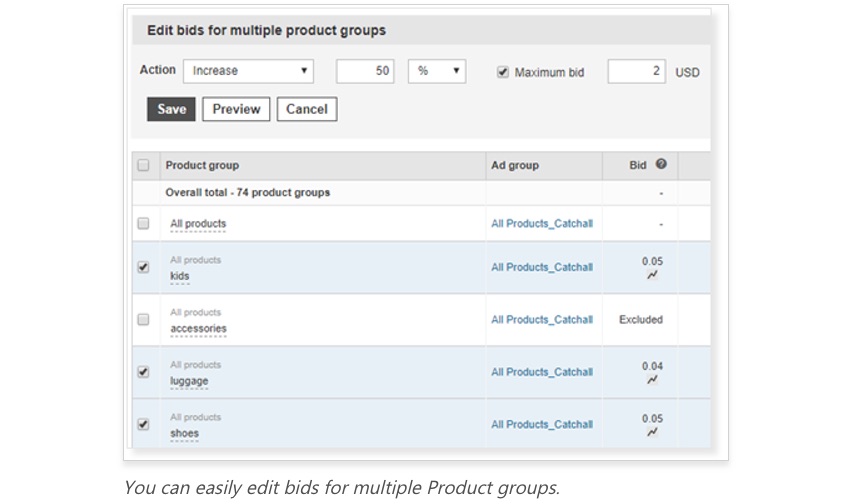
Microsoft Advertising takes a novel approach by displaying performance data alongside Product Group subdivisions. This makes it easy to see how different categories are performing so you can make smart decisions when setting up your groups. If you’re looking to enhance the performance of your Bing Shopping campaigns, this is a good place to start.
Bing has been making lots of changes to incorporate the same valuable feature sets into their shopping campaigns as Google Ads. Sponsored Products, as an example, came to Bing Ads last April, allowing manufacturers to increase the visibility of their products in search results and drive more traffic and conversions in the process.
According to Bing Ads representatives: “With this new capability, our clients can achieve better alignment of marketing efforts between manufacturers and retailers. Together, the connections they create with shoppers work harder to drive performance - clicks, conversions, and ROI.”
Microsoft Advertising Editor is a unique campaign management tool. It’s a desktop application that enables you to make changes to your campaigns online or offline, empowering you to save time by making bulk changes to your campaigns, ads, and keywords. You can manage ad copy, extensions, URLs, budgets, bids, targeting, and more.
It’s possible to manage multiple accounts from the interface and you can copy and paste elements from one account to another. It also includes keyword research tools so you can discover new keywords and add them to your campaigns quickly and easily.
Using negative keywords is a great way to ensure your ads don’t appear for irrelevant search queries. Often, advertisers compile negative keywords into large lists that they share across related campaigns. This can sometimes create problems when a negative keyword you add for one campaign could block ads from showing for relevant queries in another.
To help marketers address this issue, Bing created the Product Negative Keyword Conflicts Report. It shows you which of your product ads are blocked by negative keywords as well as their match type. The “Conflict Level” functionality will also detail at what level the conflict arose.
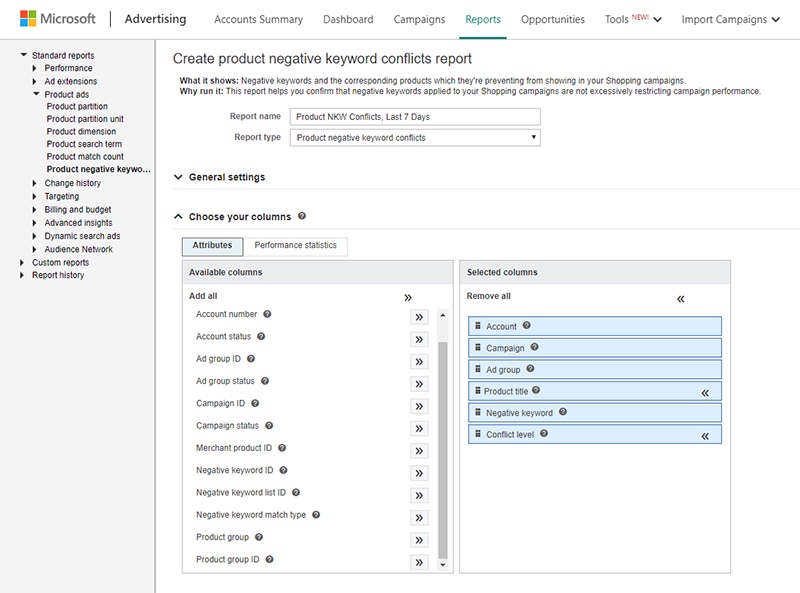
You never know when negative keywords from a shared list might be blocking your ads from showing for relevant queries. The Product Negative Keyword Conflicts Report can help you make sure your negative keywords are always working to improve the performance of individual campaigns.
After a few months of beta, Microsoft Advertising rolled out Responsive Search Ads for everyone in January 2020. They report that early adopters are seeing, on average, a 10% increase in volume, a 6% rise in CVR, and a decrease in CPA of 7%.
Similar to Google Ads, Responsive Search Ads allow you to set 3 - 15 ad headlines and 2 - 4 descriptions. Bing artificial intelligence will then automatically select the most relevant combination for each search query, ultimately ensuring you’re always targeting your audience with the most pertinent message for their interests, needs, and intent.
In April 2019 Bing Ads released a new ad extension format called Action Extensions. These are completely unique to Bing. Action Extensions allow advertisers to add 70 different calls-to-action to their ads, such as “Browse,” “Visit Store” or “Free Quote.” Advertisers can easily experiment with all the varying options to determine which ones generate more clicks and engagement. Here’s an example of what they look like on desktop search:

Local Inventory Ads are a new ad type that help brick-and-mortar businesses showcase their local inventory and retail store information within their ads. Bing uses local store inventory information and displays relevant product ads to users who are near a store’s location. Those who click on the ad are directed to the Bing storefront where they can view store location, product availability, and other helpful information:
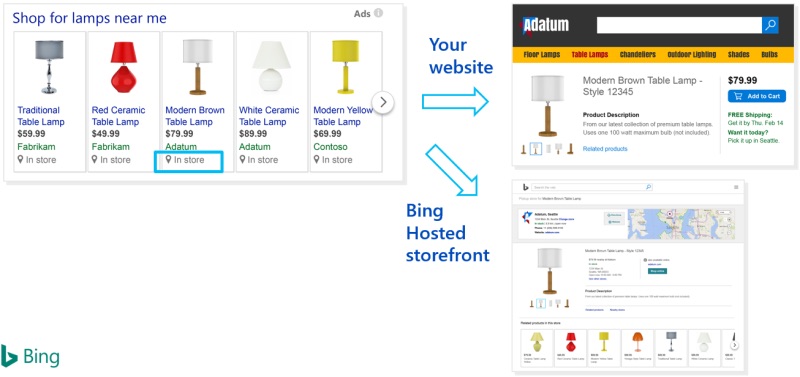
Local Inventory Ads are a valuable option because they deliver relevant information to potential customers. They also can help you get more clicks or foot traffic to your physical locations.
Copious busy advertisers tend to simply mirror their Google Ads optimizations on Bing. That’s a great place to start, but Bing has a unique audience and unique search features to employ if you’re looking to deliver peak performance. The new Bing Ads Recommendations tab can help with this. It has filters to narrow your focus on the elements that matter most, such as Repairs, Bids & Budgets, Keywords & Targeting, and Ads & Extensions. Here’s an overview of what it looks like:
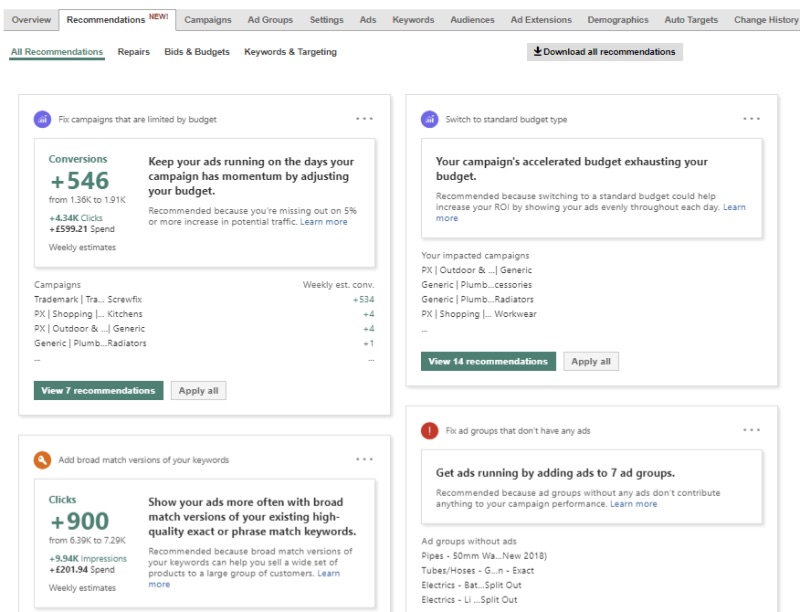
This tab doesn’t just offer suggestions, though; it also explains the reasoning behind specific improvements, making it easier for advertisers to make informed decisions about the optimizations they make. If you feel like you don’t have time to optimize your Google Ads and Bing campaigns separately, then these AI-driven insights are a great tool to utilize.
Like Keyword Planner, Auction Insights is another feature that advertisers pay attention to on Google Ads yet ignore on Bing Ads. It can help you understand how your ad performance compares to competitors. Metrics like impression share, average position, and outranking share show if you need to make improvements to your ads or bids to perform better in auctions. Tracking campaign changes and using Auction Insights metrics will help you understand if your content strategy resonates with your target audiences as well.
For a long time, Google Search audience targeting was very sophisticated while Bing trailed behind. In September 2019 that all started to change. Bing Ads released audience targeting solutions that empower advertisers to connect their own company data with relevant keywords and demographics.
Product Audiences is a new targeting option that creates remarketing lists for specific products you’re advertising. This feature dynamically pairs customers with products based on products they’ve looked at in the past. Using Product Audiences is extremely valuable as you can target people who have a clear purchase intent.
Similar Audiences is another option that automatically finds new customers who have similar interests to your existing remarketing lists. This allows you to expand your audience targeting to more relevant prospects, increasing conversions and ROI in the process.
If you’re advertising on Google and Bing simultaneously, you need to be very conscious of budget spending. Shared Budgets is a great tool that allows you to assign a single budget to multiple campaigns on Bing.

Why is this valuable? Different campaigns don’t utilize the same budget at the same pace or bring the same return. You need to strategically allocate your spend otherwise certain campaigns will finish their budget when they could have spent more, while others could end up with a surplus. This functionality automatically distributes marketing dollars to the campaigns that need it and ensures you’re always spending strategically across your entire SEM program.
Social Extensions are another tool unique to Bing Ads. They’ve been around for quite some time, but still, only a few marketers take advantage of them. Social Extensions appear under your ad copy in search results, directing your audience to social conversions on platforms like Facebook, Twitter, and Instagram. They are a great option for advertisers who want to nurture leads and encourage engagement with audiences who might not yet be ready to convert. You can use social extensions alongside other ad extensions to increase engagement while also targeting other goals, like CTR.
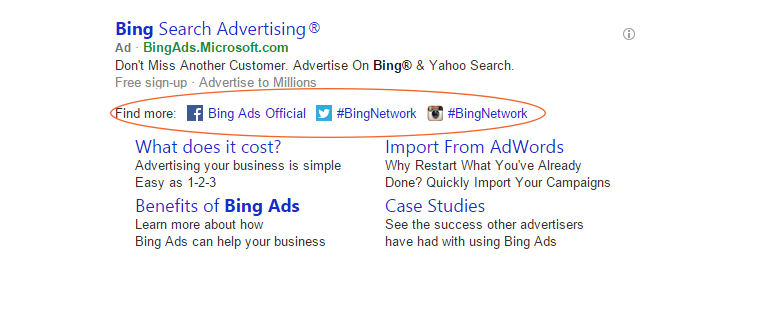
Bing Ads has made a great many changes that have made it easier to expand your SEM strategy beyond Google Search. Now they’re starting to develop new features and capabilities that allow advertisers to maximize their revenue potential.
Mirroring your Google Ads strategy on Bing is a great approach when you first start out on the platform, but performance marketers should be prepared to develop a unique blueprint for Bing PPC using all the most valuable tools and resources. Start taking advantage of these 13 features today and keep an eye out for new opportunities to drive ROI with future developments from Microsoft Advertising.
Performance marketing is a simple concept. Investment in strategies that deliver performance results: more clicks, more leads, more sales, more revenue. Choosing the right performance marketing strategies, however, has become more difficult in recent years. Now there is an abundance of marketing channels to invest in, myriad technologies to choose from, and a wealth of changes happening in the digital landscape to keep pace with.
To succeed in performance marketing today, it’s essential to first invest in the right strategies then work diligently to optimize your efforts. There’s no time and no extra budget for trial and error. In this article, we present 10 of the top performance marketing strategies for 2020 and beyond, all based on the latest trends and opportunities.
Today, there are nearly 50 times more technology providers in the marketing ecosystem than there were a mere eight years ago. Even small businesses must utilize a number of tools to manage their marketing across various channels. Larger businesses are faced with building a complete MarTech stack, which must include an array of tools that help them automate and analyze performance.
Just how much return you get out of your investment in marketing technology really depends on the value of each tool and how well it integrates with your other software. Since new technologies and features are constantly being released, marketers should regularly reevaluate their MarTech stack to ensure they’re always using the most valuable solutions for their needs.
Here are some important questions to ask when evaluating your MarTech arsenal:
Google, Bing, Facebook, and Amazon offer a significant amount of valuable consumer data that marketers can utilize to better target their audiences. These platforms - referred to as “walled gardens” - are dangerous options, though, because they completely own and control the data on offer.
Gartner recommends that marketers avoid data dependence on walled gardens so you can get the most valuable customer insights for your business. To begin, ensure you have a way to store and manage your own first-party audience data. Then you can invest in third-party data from private marketplaces (PMPs). PMP data can be expensive, but it’s higher quality and you can analyze it however you want. Gaining insights from third-party data can be just the advantage your business needs to stay ahead of the competition when everyone is making use of data from the same walled gardens.
Amazon’s advertising revenue skyrocketed in 2018 and continued to bring impressive revenue in 2019:
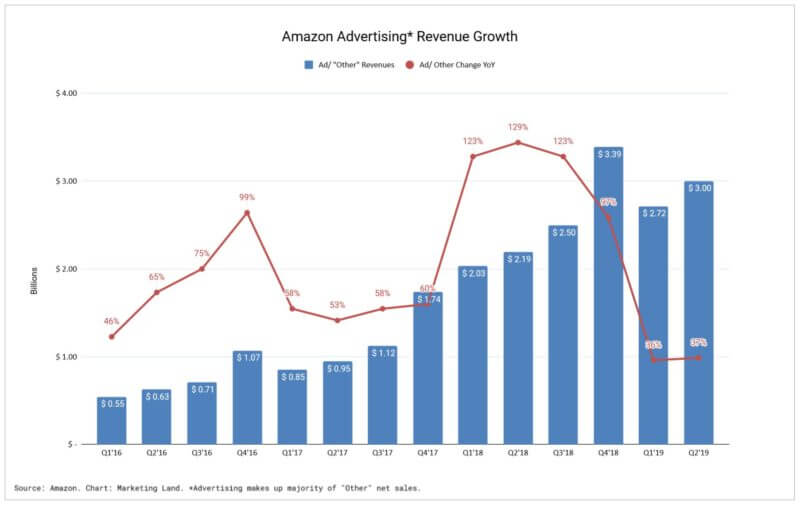
While performance has now leveled out, Amazon advertising is still expected to grow in importance in 2020 and beyond. This is because Amazon is diversifying its advertising options beyond simply on-site display ads. Forward-thinking advertisers should invest in Amazon demand-side platform (DSP) sooner rather than later. Amazon DSP is a special advertising alternative that allows you to programmatically reach your audiences across the web. Options include Amazon-owned sites (e.g. IMDb), third-party exchanges, and other leading publishers through Amazon Publisher Services.
Amazon executives have frequently expressed their intent to invest more in expanding the platform’s advertising options. DSP already offers exclusive audience access to help marketers reach their ideal customers on Amazon and off. Investing in DSP before it becomes mainstream will give performance marketers critical advantages in a competitive market.
Advertising platforms are constantly bringing out new ad types and features to better suit the goals of marketers. Performance strategies should always allocate some budget for testing out these options. As an example, Google recently released lead form ad extensions for search ads, allowing advertisers to capture contact information right from search results:

Facebook also has a variety of new ad types that can help you reach audiences in a unique, relevant way, such as Messenger Ads, Canvas Ads, and Collection Ads. Regularly experimenting with new ad types ensures you’re always using the most effective options that resonate with your audience and drive marketing goals.
Major advertising platforms like Google and Facebook offer dynamic options that automate ad development. Most marketers assume they can create a more relevant advertising message than AI-powered machines could, but testing out dynamic ad options can also provide inspiration for manually created ads.
Dynamic ad creative also has the advantage of combining the right ad elements based on the interests of individual audience members. Dynamic Search Ads (DSAs), for example, include user search queries in ad headlines to make them more relevant to searchers. Regardless of how well targeted your ad copy is, adapting it to each member of your audience has significant advantages, driving more clicks and conversions.
Whenever Google makes changes to its advertising platform, the goal is to benefit their advertisers. The more effective your ads are, the more revenue potential there is from Google. Rather than resisting these changes, then, it’s usually good practice to embrace them. A notable example is when Google Adwords rebranded to Google Ads to deemphasize the role of keywords and encourage advertisers to make use of audience targeting options. Audience targeting is now an essential strategy of any optimized PPC campaign.
Last year Google made some more changes by adding new ad position metrics, including:
Here’s what top and absolute top look like on a search results page:

The goal was to help advertisers understand and appreciate the role of ad position in overall performance. To this day, though, few have added these metrics to their analytics dashboards or considered targeting impression share over other metrics.
Bidding to target the first page of search results is essential if you want your ads to get any visibility and clicks at all. But bidding to target positions above organic search results or the top spot on the page can bring many more clicks and conversions than other targeting strategies ever could. Google added these new impression metrics for a reason, and performance marketers would be smart to utilize them.
Facebook may be the biggest social channel, but it’s far from the only option. In 2020, performance marketing strategies should include testing out other social platforms, such as LinkedIn, Twitter, or Snapchat. While these alternative social media platforms may not give you as much reach as Facebook, they can certainly help you reach more niche audiences.
The landscape of social media is one that is constantly changing. Facebook has recently seen a huge drop in users, especially amongst younger demographics. Twitter’s user base, meanwhile, continues to grow. This Statista graph shows the number of active Twitter users worldwide over the last decade:

If marketers don’t start diversifying, they’ll never fully understand the opportunities there are to reach audiences on different social platforms.
Omni-channel marketing is an essential aspect of all performance marketing strategies today. Building brand awareness and converting leads means targeting them effectively on different platforms across the web. And the only way you can truly learn from your marketing performance is by attributing conversions to various touchpoints across the web.
Businesses today have many options for marketing attribution. But few develop sophisticated attribution models that reflect the true complexity of the customer journey. Today’s performance marketers need to invest in data management and attribution technology that can analyze data from all relevant marketing channels. It’s also essential to create custom attribution models that reflect the real value of your marketing collateral.
Whether you rely on Google, Facebook, or another third-party tool, you should always test out and compare different attribution models to see how performance pans out. As performance marketing has become the norm, it’s now impossible to rely on one-dimensional models such as first or last-click attribution.
Most enterprise businesses consider building an internal marketing team versus outsourcing as two dichotomous options. You either invest the time and money to train your employees in various marketing tasks or you rely on skilled agency personnel to handle it. But what many don’t realize is that combining strategies can be the most efficient and cost-effective for your business.
According to Gartner’s latest spending survey, CMOs are spending less and less on agency services despite investing more in MarTech:

Many marketing software companies also offer agency services to streamline onboarding and help you get the most value out of their tools. Rather than investing in training your team to use the software, it makes sense to outsource to agencies that are experts in driving ROI. This also frees up your internal marketing team to focus on other marketing tasks, such as growth and development.
Google’s Automated Bidding has been around for a while now, yet performance marketers shouldn’t take Google’s word for it with automation. It’s better to experiment with different automated strategies as well as custom targeting and bid adjustments to see which performs best for your unique needs.
Performance marketers need an automated bidding strategy that targets the right combination of value-based metrics for their unique goals. And if Google’s options don’t fit your needs, then third-party tools can. QuanticMind is an automated bidding technology that allows advertisers to target Revenue-Per-Click. This sophisticated bidding strategy considers an array of value-based metrics beyond what Google Ads automation has to offer.
When investing in automated bidding in 2020 and beyond, be sure to evaluate all the targeting options available.
These 10 strategies are just a few of the many paths you can take with performance marketing. The key to success is investing in strategies that offer the most potential for business growth. Whatever options you choose, ensure you monitor performance comprehensively. Accurate analytics insights ensure you always make informed changes to your campaigns, maximizing the value of each marketing channel for your business.
Content marketing is one of the most common strategies B2B marketers use for demand generation. According to an eMarketer report, B2B marketers primarily produce content to drive sales, among other important marketing goals:
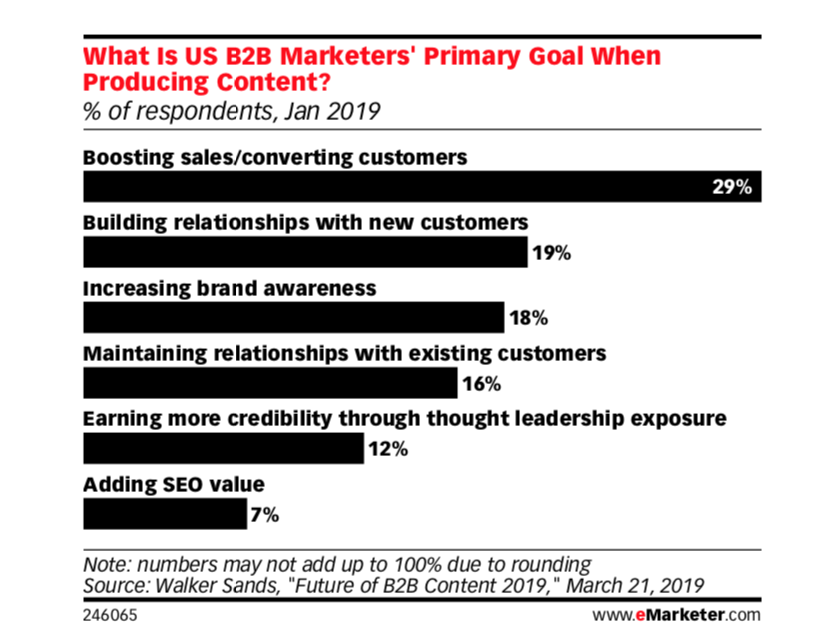
Creating and distributing content to your target audience on key platforms works well for B2C, but while it's an important aspect of B2B marketing, this strategy may not always be enough to achieve B2B marketing goals.
Since you’re ultimately targeting a business—not individual people within it—your content needs to be relevant to all key players throughout the customer journey. One of the best ways B2B businesses can address this issue is with an account-based marketing (ABM) approach.
Account-based marketing is a strategy that focuses on the success of the entire customer experience, both pre and post-sale. To understand the difference, it’s best to compare it to traditional inbound marketing. Inbound marketing involves focusing the majority of a given budget and targeting efforts on generating leads with compelling offers. It prioritizes getting high volumes of relevant traffic to click through to a landing page, where only 1-2% will actually become paying customers.
ABM instead distributes more time, money, and energy to different stages of the customer experience, including lead generation, acquisition, post-sales, and success. Businesses that utilize ABM invest more in accounts that are likely to close, rather than spending a little on a wide variety of leads that likely won’t turn into sales. They also employ strategies that empower them to build lasting relationships with their customers, leading to new sales opportunities and increasing their lifetime value.
Account-based marketing can be incredibly effective at driving business goals, but the strategy wasn’t always an option in the past. In order to identify the right accounts and effectively target them, businesses need to use significant amounts of relevant behavioral and business data that simply wasn’t available five to 10 years ago.
You need to have access to quality data sources and be prepared to analyze all relevant data to inform account targeting decisions. Some examples of important data for ABM include:
Audience behavioral signals
These can be any relevant signals that indicate a business could benefit from your products or services (even if they’re not actively searching for businesses like yours). Important data points vary based on industry. For example, posting new job positions could suggest relevant internal business changes.
Intent data
This also falls under behavioral signals, but they’re specific actions that suggest an intent to make a purchase. Drawing correlations between the kind of content target leads are consuming across the web reveals what their underlying intent is.
Engagement data
How are accounts and associated individuals engaging with your brand, online and off? This is often tracked using CRM or marketing automation technology.
Performance data
This includes any relevant data that sheds light on the performance of your ABM efforts. It can relate to your marketing campaigns, sales cycle, close rates, retention rate, and more.
These are just a few categories of data account-based marketers can use to develop their strategies and optimize their efforts. The more relevant, fresh data businesses can process and derive insights from, the more opportunities there are to improve B2B demand generation and marketing.
Successful ABM requires buy-in and strategic changes at all levels of your business. Here are some key areas that B2B businesses need to focus on to achieve this:
Aligning Relevant Teams
Despite what the name suggests, ABM is about more than just marketing. Many different teams throughout your business serve some kind of role in the customer journey and experience. In order to succeed at ABM, it’s important to bridge gaps between these different departments to ensure they’re all on the same page.
This includes:
Mapping Your Customer Journey
Mapping the customer journey from the account perspective is incredibly important. Rather than building buyer personas for individual people, B2B marketers need to consider the entire business and the individual people they might interact with at various points in the customer journey. The aforementioned eMarketer report also outlines a B2B customer journey map framework, including eight key audience milestones:
Pre-Purchase
Post-Purchase
ABM considers audience perspective at each of these stages. Doing so can have a huge impact on the strategies you use to market to them. For instance, different stakeholders will occupy the main touchpoints at different phases in the customer journey. You could be marketing to someone in IT for milestones one to three, then switch to the COO for making a purchase decision. When marketing to IT, you focus on the benefits of your solution to their specific job, but with the COO, it makes more sense to focus on the potential to drive revenue, reduce wasted spending, etc. Milestones in the post-purchase phase could also differ in this way.
So, based on your previous knowledge of marketing to your target audience, build a clear customer journey then create a relevant marketing strategy for each stage. Over time as you market to more accounts, you’ll realize and adapt to common changes at different milestones from the account perspective.
Aligning Relevant Technologies
Aligning your various teams is step one, but aligning relevant technologies is equally important. Tools need to share data to help different departments communicate with each other. For example, your CRM tool and marketing automation software should share data automatically. It’s also important to properly track all relevant key performance indicators (KPIs) so you can evaluate the effectiveness of your ABM strategy.
Because ABM is so data-driven, you might need additional technologies beyond your current MarTech stack. Consider all relevant business data you might need (audience behavioral signals, performance data, engagement data, etc.). Do you have the right analytics technology equipped to integrate and process all this information?
An Action Plan for Optimization
Success in ABM relies heavily on learning from your efforts. You’re adding new elements to your marketing strategy (sales, customer success, finance, etc.). So you need to effectively monitor their impact on reaching your marketing goals, then make targeted changes to your strategy to improve performance. This should be an ongoing, standardized process that all teams are invested in. Different siloed departments should be prepared to make or suggest changes to their strategies based on overall ABM goals.
The faster your teams can implement changes based on performance data insights, the more opportunity there is to benefit. This is another area where key technologies come in. Marketing automation technologies can help you make quick changes based on the most relevant data insights. More sophisticated bidding solutions can make targeted bid adjustments based on current and historical performance, ensuring you always spend the right amount on advertising to meet your ABM goals.
Advertising is one area of B2B marketing that can benefit significantly from an ABM approach. Here are some of the many ways ABM and advertising complement each other, generating more demand and sales:
1. Target all relevant personas
As mentioned above, it’s important to target all invested personas within a business. According to a recent Gartner survey, 75% of B2B customers agree that their purchase involved people from a wide variety of roles, teams, and locations.
Advertising gives marketers a unique opportunity to do this at scale. Google Adwords retargeting, for example, can help you target display ads to all members of the buying committee that you have contact information for. Using keyword and audience targeting, you can also reach key personas with your search advertising campaigns.
2. Discover more potential accounts
Account-based marketing is largely about targeting businesses that you already have some degree of relationship with. Maybe they visited your booth at a trade show or interacted with your business online. You’re not spending time prospecting for cold leads.
That said, advertising gives you an opportunity to discover new leads that you wouldn’t find otherwise. Your ads build brand awareness and attract traffic to your site. Then you can segment out the visitors who expressed some interest by reading your product pages or downloading resources. Over time, these can become new target accounts.
3. Personalize your marketing message
Since your ads are targeting different personas within a business, they should be tailored to the persona in question. It’s possible to do this using a variety of advertising options. Dynamic Search Ads, for instance, allow you to change the text of your headlines and subheadlines based on user search queries.
Elsewhere, LinkedIn Dynamic Ads offer further opportunities to personalize your message for individual players based on profile data, including their photo, company name, job title, and more. Creating relevant content and landing pages to target key decision-makers is a start, but it’s also incredibly important to create personalized ads to generate traffic in the first place.
4. Use advertising metrics for behavioral scoring
ABM professionals often use behavioral scoring to evaluate the potential of a given account. Marketing automation platforms can monitor how often an account interacts with your business and in what capacity to determine their potential value as a lead.
Incorporating advertising into your ABM strategy can improve the quality of your behavioral scoring efforts, ensuring you don’t miss out on valuable sales opportunities. Advertising brings more website traffic, and thus more touchpoints to analyze. Factoring in ad impressions, clicks, page visits and other metrics of on-site behavior provides much more context to the value of a potential lead. Suddenly all site visitors can become potential sales leads, not just people who fill out your lead forms.
5. Scale Quickly
Targeting accounts with organic marketing strategies takes a lot of time and effort to scale. Investing in advertising gives you the opportunity for major growth right from the beginning. Between Google Ads, Facebook, LinkedIn, and other advertising verticals, it’s possible to generate as many qualified accounts as you can handle.
Automation technologies can also help you market to these leads at scale. As mentioned above, intent data is valuable in helping account-based marketers identify potential accounts to target. Once a new lead expresses interest in your product niche online, you have a limited amount of time to target them with ads before they make a purchase decision.
Automated bidding technology is able to process large volumes of intent data as it comes in, then make targeted changes to your advertising initiatives in real-time. Targeted bid adjustments can increase your ad visibility in the buying cycle when it matters most. What’s more, there’s no need to rely on your internal teams to manually identify these opportunities and make necessary adjustments. Advertising automation helps with demand generation, allowing internal teams to focus on needle-moving initiatives like lead nurturing and sales.
The saying “content is king” is not new in marketing. Creating relevant content for your target audience is more valuable now than ever for marketing. The real challenge lies in understanding exactly which personas to target and gaining visibility for your content on the right channels.
Consider these recent B2B content marketing statistics:
B2B businesses have a huge opportunity to generate demand with content if they invest heavily in its creation and distribution. Here’s a summary of how B2B businesses can get the most out of content marketing to achieve their marketing goals:
Most B2B businesses today invest in content marketing as an ad-hoc initiative. Once you become proactive and start targeting diverse personas with an account-based approach, the competitive landscape changes completely. ABM offers a unique opportunity for B2B businesses to target high-quality leads at scale.
Today’s eCommerce businesses have many options when choosing advertising platforms to work with, but the digital marketing landscape is constantly changing, along with the needs of advertisers. Platforms must keep up with these transformations in order to help eCommerce businesses drive more sales and revenue in the long term.
Rather than change platforms year after year, advertisers should invest in solutions that can tackle these changes and adapt. Here are the biggest challenges eCommerce advertising platforms face in 2020, and how they can address them.
Marketers’ responsibilities for data security and privacy continue to grow. The European Union’s General Data Protection Regulation (GDPR) has been in effect for several years now. There’s also a strong digital privacy law in California, while new legislation is regularly introduced that could pass into law at any time. As such, data security is a top concern for eCommerce businesses today.
Marketers that work with large media management platforms like Facebook, Amazon, and Google have less legal liability because the data they use is owned and managed by those entities. Businesses are still responsible for properly managing their own first-party data, though, unless they process it all together using features like Facebook Pixel. At the same time, relying too heavily on big players like Facebook or Google gives you no control over your own data management or analysis at all.
That’s why many eCommerce advertisers today turn to mid-size data management platforms to help them meet regulatory standards while still maintaining control of their own data.
Digital marketers recently surveyed reported that data privacy and tracking had the largest impact on business last year:
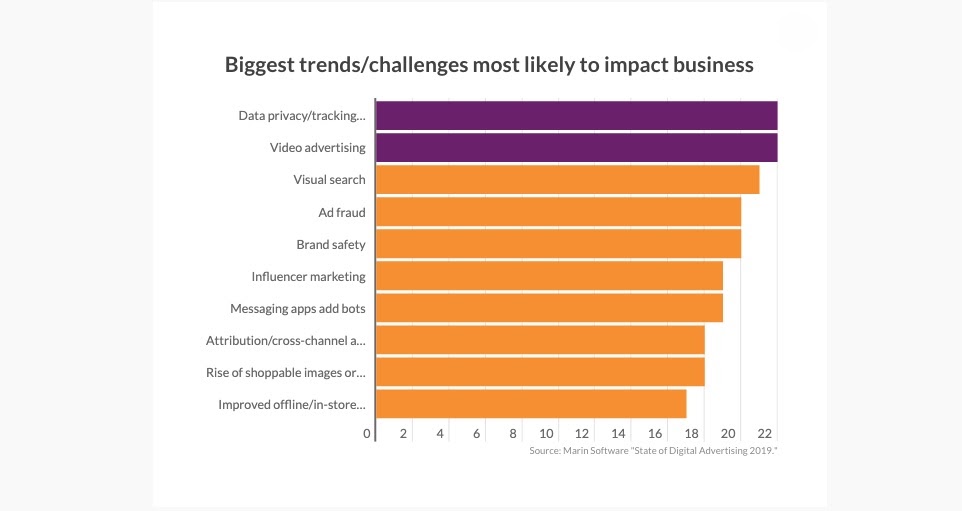
Rather than leaving it all up to individual businesses to meet data regulations, advertising platforms should step up to the challenge by offering internal features to facilitate this. For example, it should be easy to view the data profiles of individuals, so businesses can easily manage, export or delete this information at their request. Another important feature is offering transparency and options for people to participate in data collection or not.
Advertising platforms today offer a huge opportunity to automatically target and convert leads once they show purchase intent. Ninety percent of smartphone users are not absolutely certain of the specific brand they want to buy when they begin looking for information online.
That said, there’s often only a short window of time to target in-market audiences before they make a purchase decision. Consider a woman shopping around for leather boots online. She visits a few eCommerce stores then makes a purchase. An hour or two later, she starts seeing remarketing ads for the boots she just bought.
Targeting these “micro-moments” before people make a purchase decision requires automation capabilities beyond simple remarketing ad campaigns. Advertising platforms must be prepared to process relevant audience behavioral data in real-time, helping businesses reach shoppers before they buy.
Beyond making fast automated bid adjustments for audiences that show purchase intent, advertising platforms can also help businesses target relevant audiences before they demonstrate their intention to buy. QuanticMind by Centro, for example, uses machine learning technology to process large amounts of audience demographic and intent data. Algorithms are able to identify the kinds of people who would be interested in a product before they start searching for it.
The advertising landscape is highly competitive, while consumers make quick decisions when buying online. Today’s eCommerce businesses need platforms that offer advanced data insights to anticipate audience interests and target them ahead of time.
Businesses today have many options when choosing advertising platforms. The platforms themselves make efforts to stand out from the competition by offering unique solutions to specific advertising needs, such as search optimization, social, eCommerce, etc. This “best-of-breed” approach increases the value of certain platforms for some businesses but limits their applicability to omnichannel marketing.
Meanwhile business leaders today are feeling more pressure to invest in solutions that help them manage all their advertising needs. Just a few years ago, Google and Facebook were the only major players in the advertising market. Now Amazon is seeing fast growth.
If advertising platforms want to remain valuable to eCommerce businesses in 2020 and beyond, they need consolidated offerings that help advertisers build an omnichannel approach to marketing. This includes features that help businesses strategically plan, buy, and optimize ads across paid media touchpoints, as well as generating insights to improve performance.
Search-focused platforms are uniquely positioned to adapt and meet this need since search is still the main paid channel for many brands. Expanding targeting and optimization capabilities to include social and Amazon is a great place to start.
Audience targeting options in advertising are more nuanced today than ever. Using the right advertising platforms, it’s possible to target just about any relevant consumer with ads all over the web. But helping businesses do this can actually hurt their relationship with some audience members while helping it with others.
Simply put, not all people appreciate or care about ads. According to Forrester’s latest Omnichannel Advertising Playbook, only 42% of US online adults think advertising is a good way to learn about new products. For some people, targeted advertising is a great way to nurture leads. For others, it’s a strategy to alienate and annoy them.
Ecommerce advertisers today are highly concerned with delivering a relevant message to their audiences based on their preferences and needs. As a result, top advertising platforms need to help businesses by offering flexibility in targeting options. Sometimes, simply maximizing ad visibility across the web is not the right approach.
As businesses learn more about their leads, they can make informed decisions about what kind of advertising message to deliver, where to deliver it, and at what frequency. They need to understand:
All of this can be automatically tracked using a customer relationship management (CRM) platform. Advertising platforms that integrate well with CRMs and allow users to automate changes to their ad targeting strategy based on CRM data are well equipped to address this issue for businesses.
Advertising platforms today need to have enough flexibility to allow businesses to train their algorithms to consider the best interests of consumers over plain performance indicators like impressions or clicks. Delivering intrusive ads to people who aren’t interested can hurt their advertising efforts, decreasing the value of investing in advertising platforms in the long run.
Delivering personalized ads is the key to success with paid media today. Lots of people don’t even pay attention to ads. And those that do are most annoyed when shown ads that are irrelevant to them. Personalization opportunities are so great that consumers have come to expect them. According to Salesforce’s State of the Connected Customer report, in 2020, 51% of consumers expect companies to anticipate their needs and make relevant suggestions before customer contact.
In recent years, data regulations and the death of tracking cookies have made it very difficult for eCommerce businesses to target leads with a personalized message. Advertising platforms need to help address this need by facilitating ad personalization.
Adapting your strategy to consumer preferences (mentioned above) is one part of this. Offering features that help businesses build dynamic ads and landing pages is also an option for personalization at scale. Most importantly, advertising platforms can help by anticipating the interests and needs of audiences before they start shopping. This is done using full-funnel data insights and machine learning technology to make educated inferences.
Even in cases where consumer data is scarce, AI-driven algorithms can draw correlations between other related data, making inferences about the kind of people that could be in-market for products like yours. Instead of relying on reactive remarketing campaigns to deliver personalized ads, advanced technologies can help businesses reach audiences with a personalized, relevant message in advance.
Google has been the leader in advertising automation for years now. Over time they’ve rolled out numerous new ways to automate bids, ad targeting, ad content, and more. Today, Smart Campaigns are the default option for new advertisers. Automation allows new advertisers to compete in their market without so much of a learning curve. But automation is equally valuable to enterprise-level businesses looking to streamline optimizations based on performance insights to scale their advertising strategy.
However, not every aspect of eCommerce advertising can be “set it and forget it.” Businesses want and need some control over the algorithms that run their advertising campaigns today. Alternative automation technologies are charged with offering flexible solutions that allow users to benefit from streamlining automation, while also providing enough insights and control for their unique business needs.
To start with, third-party advertising automation technologies can offer better insights with a unified data approach. Google Ads relies on data from Google properties to inform automated bidding decisions. Third-party technologies can use this data as well as other relevant business data to make more accurate bidding decisions. QuanticMind by Centro can analyze historical revenue and click information, offline revenue data, deep funnel data, cost data from publishers and more to offer better insights and optimization from automated bidding.
Another area where advertising platforms can offer more control for advertisers is strategy. Google’s automated bidding offers a number of goals advertisers can choose from that dictate the choices of bidding algorithms, such as Target Return on Ad Spend or Maximize Conversions. But eCommerce marketing goals are rarely single-dimensional. There are a number of key metrics that are important for businesses to work towards. Advertising platforms can address this need by offering more nuanced and multi-faceted goal targeting options to inform automated bidding decisions.
Whether you’re just getting started or already invested in an advertising platform, it’s important to evaluate platform features and capabilities in 2020. Key trends from 2019 illustrate the importance of choosing the right advertising platforms to reach business goals today:

Investment in advertising data management and automation is growing immensely. Meanwhile businesses want to utilize more data, targeting and optimization features than ever before. Lastly, investing fully in an omnichannel approach means looking beyond using Google Ads, Facebook and other advertising platforms in isolation. eCommerce businesses need an integrated solution that helps them stay competitive in the advertising market.
With that in mind, here are some important tips for evaluating eCommerce advertising platforms in 2020:
Start with your current vendors.
Adopting new marketing technologies is always a significant undertaking for a business. So it’s best to take stock of your current capabilities and see how they measure up against your needs. That way you can focus on only adding necessary technologies to your MarTech stack.
Look for sophisticated data management capabilities.
Advertising technologies can and should double as data management platforms. In order to gain the real-time insights eCommerce businesses need, platforms must store and process large amounts of new and historical data from first, second, and third-party sources. Since data privacy regulations are a growing concern for advertisers, providing a solution is essential for platforms to stay competitive in the long term.
Minimize the number of tools you need.
Some enterprise businesses prefer to invest in all the “best-of-breed” technologies for their advertising needs. But this strategy tends to bring more problems than benefits. The more advertising technologies you use, the more integrations they need. You’ll also have to onboard each platform within your business. As omnichannel marketing becomes even more important, that just means more tools to bring on. It’s better to focus on using a few key solutions that offer the most value for your time and investment overall.
Give value to flexibility.
Most technologies prioritize offering advanced automation solutions to make it easier for advertisers. But the challenge is finding a platform that also offers the flexibility businesses need to reach their unique marketing goals. Give value to tools that help you take advantage of automation while maintaining control of audience targeting, bid strategy, and more.
Ecommerce businesses today don’t have the capacity to invest in new advertising technologies every year. It’s best to ensure you choose the best solution that will adapt to your needs and the market landscape in 2020 and beyond. Centro has a track record of evolving and tackling these top challenges as they come along.